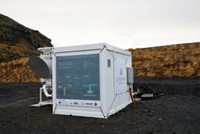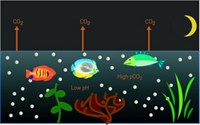Advertisement
Grab your lab coat. Let's get started
Welcome!
Welcome!
Create an account below to get 6 C&EN articles per month, receive newsletters and more - all free.
It seems this is your first time logging in online. Please enter the following information to continue.
As an ACS member you automatically get access to this site. All we need is few more details to create your reading experience.
Not you? Sign in with a different account.
Not you? Sign in with a different account.
ERROR 1
ERROR 1
ERROR 2
ERROR 2
ERROR 2
ERROR 2
ERROR 2
Password and Confirm password must match.
If you have an ACS member number, please enter it here so we can link this account to your membership. (optional)
ERROR 2
ACS values your privacy. By submitting your information, you are gaining access to C&EN and subscribing to our weekly newsletter. We use the information you provide to make your reading experience better, and we will never sell your data to third party members.
Hydrogen Power
Lhyfe explores offshore green hydrogen, ocean reoxygenation
Cleantech developer hopes to use O2 byproduct to aid the ocean, but scientists aren’t sure it would work
by Craig Bettenhausen
August 11, 2023

While most of the green hydrogen world is understandably focused on hydrogen, the project developer Lhyfe is also looking at the other product of water electrolysis: oxygen. The firm is funding research into the potential to use oxygen made at its planned offshore hydrogen plants to combat the deoxygenation of seawater, an environmental problem linked to climate change.
“At Lhyfe, we have the ultimate ambition to responsibly implement ocean reoxygenation as a measure to mitigate ocean deoxygenation,” says Patricia Handmann, a science advisor at the firm, in a press release about the research. “During the production of 1 kg of sustainable green hydrogen, through electrolysis of water, 8 kg of oxygen are produced as a byproduct. Our vision, at Lhyfe, is to give back this oxygen to the ocean to support its resilience and/or restore the functioning of marine ecosystems.”
The world’s oceans are losing oxygen because of overlapping impacts from human activities, according to Scripps Institution of Oceanography. At the simplest level, oxygen is less soluble in warmer water, and the ocean is absorbing more than 90% of the warming caused by greenhouse gases.
The warming also interferes with ocean currents and other natural mixing mechanisms that distribute oxygen, nutrients, and heat. At the same time, fertilizer runoff and wastewater add nutrients such as phosphorus and nitrogen to the water, which can lead to algae blooms and subsequent die-offs that consume large amounts of oxygen.
But experts caution against going down the reoxygenation road too quickly.
“It is admirable that these folks are looking to take advantage of the oxygen byproduct from the hydrogen generation,” says Christopher M. Reddy, a senior scientist at Woods Hole Oceanographic Institution. “There is some deoxygenation from increased ocean warming and excess nutrients that overfertilize the surface ocean.” However, he says “much of the surface ocean’s oxygen drawdown is location- and time-specific. Will they inject their oxygen byproduct at the right time and place to lead to a measurable and meaningful difference?”
Lhyfe’s first step is funding academic research into the idea of artificial ocean reoxygenation. The initial paper from the work concludes by urging caution and further study (Environ. Res. Lett. 2023, DOI: 10.1088/1748-9326/ace0cd). The modeling study, conducted by researchers in France and Norway, predicts that localized oxygenation could shrink the size of oxygen-depleted pockets of seawater, called oxygen minimum zone (OMZs), by 1.1 to 2.4%. However, interaction with the nitrogen cycle in some areas could promote microbial blooms that ultimately result in a net loss of oxygen in the water column.
Govind Rao, a professor of chemical, biochemical, and environmental engineering at the University of Maryland, Baltimore County, says mixing and solubility would create barriers in a real system. “While in theory, that oxygen generated could be injected into an oxygen-deficient zone, the issue is: How would it be distributed and mixed? We are talking about hundreds of square miles that these zones span, with depths of several meters,” he says. “A simpler solution would be to have hundreds of little solar-powered buoys that aerate the ocean by pumping in air to oxygenate the water.”
Overall, Reddy urges caution when adding anything to the environment. “You can even imagine an argument that oxygen is safe, so adding it to the ocean cannot be a problem,” he says. “Perhaps that is the case. But I would not assume the issue and would expect a dedicated monitoring program at every location. Bottom line—is their good thing a good thing?”
Handmann acknowledges that the results so far are not a green light to start pumping oxygen into the sea. “The results show that industrial large-scale artificial ocean reoxygenation could have an impact on the global OMZs and has to be treated with great care,” she says in the press release. “Further studies are needed on a regional scale.”
Nonetheless, Handmann says, “we want to promote our vision of ocean reoxygenation as an environmental service of offshore hydrogen production. And we want to do it rather today than tomorrow.”
Lhyfe is actively developing a handful of green hydrogen projects on land and at sea. Since the fall of 2022, the company has been testing a 1 MW offshore hydrogen plant that runs on wind power and can produce up to 400 kg of hydrogen per day. Building on successful results from that pilot plant, Lhyfe recently won a $22 million grant from the European Commission to build a 10 MW offshore hydrogen plant that would make 4 metric tons of hydrogen per day.





Join the conversation
Contact the reporter
Submit a Letter to the Editor for publication
Engage with us on Twitter